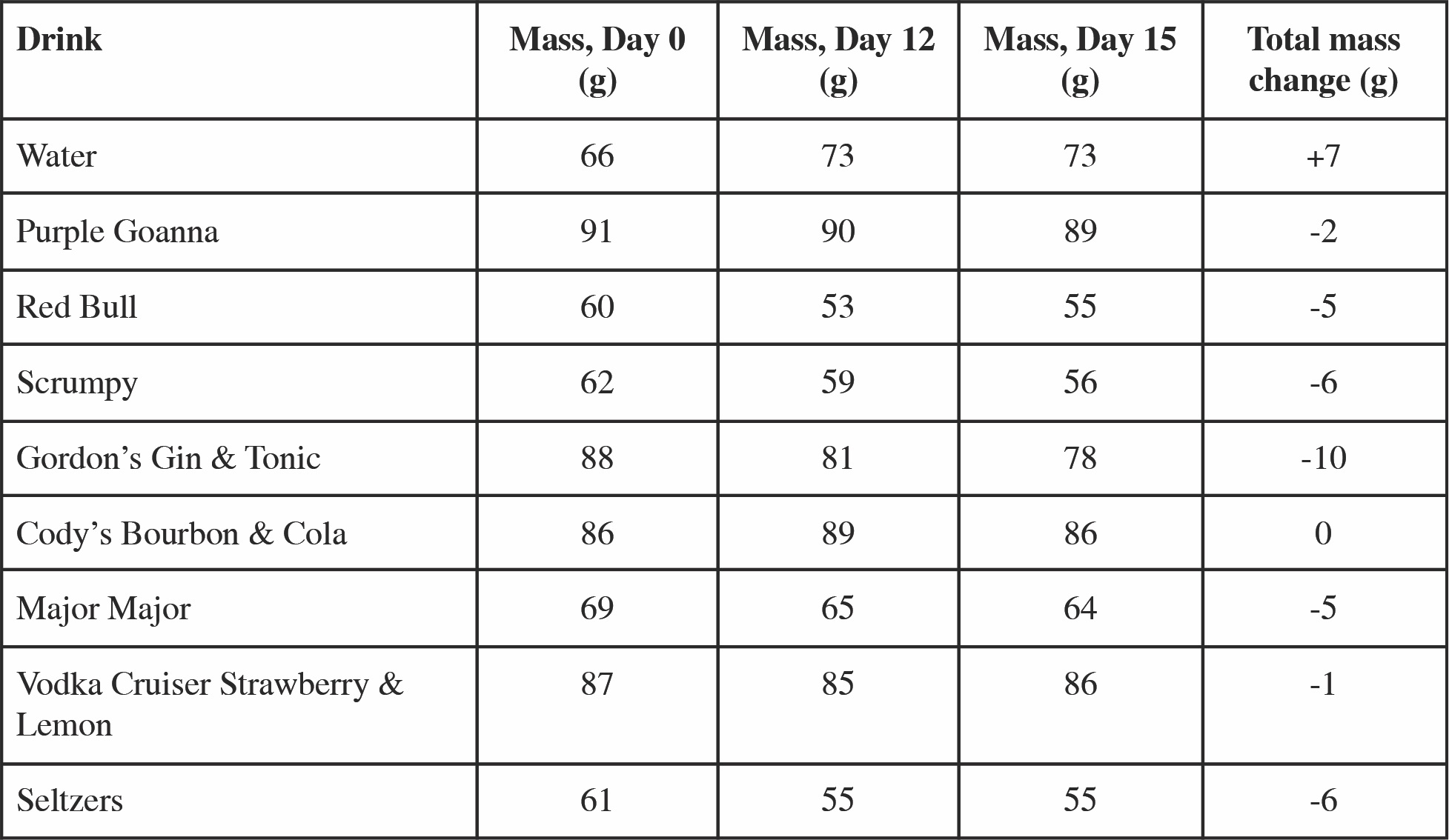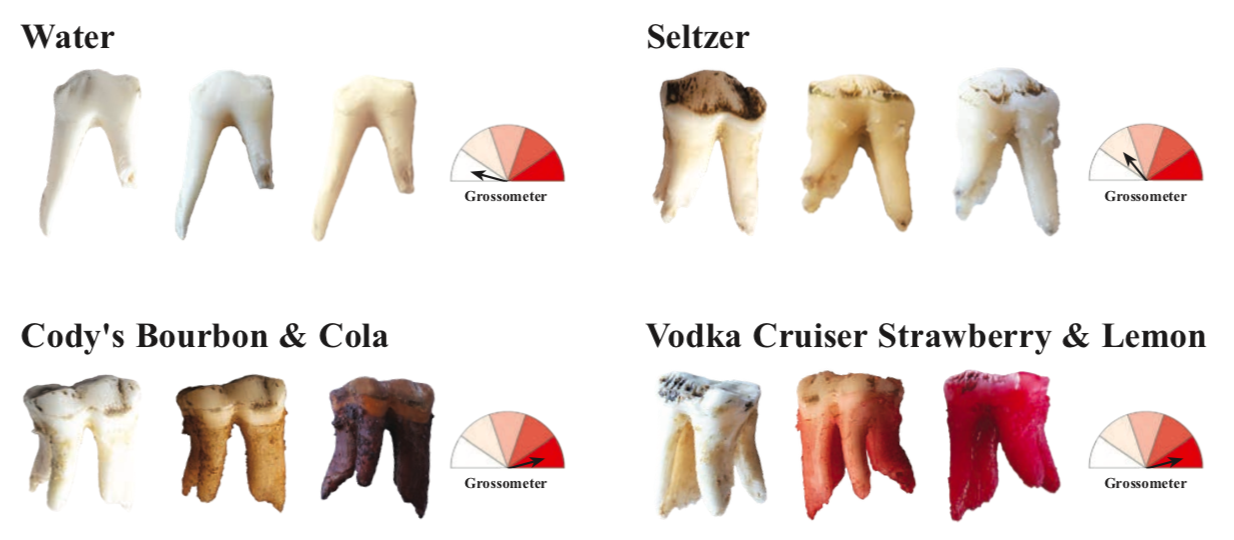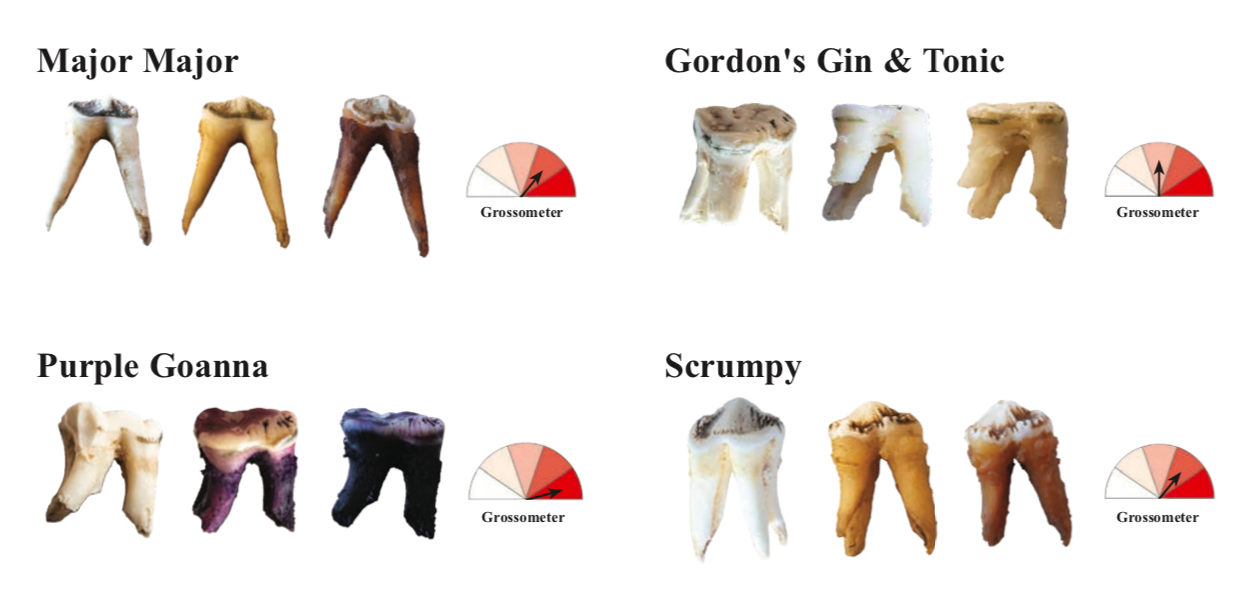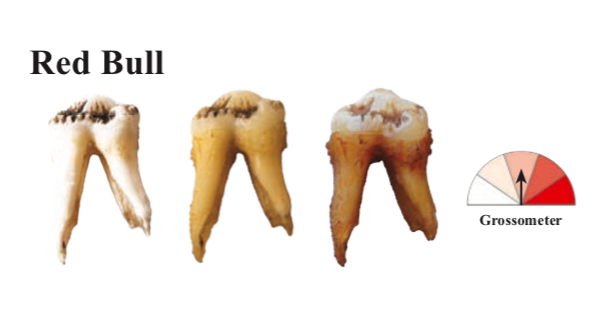Abstract
This little piggy went to market, this little piggy stayed home. Eight little
piggy’s teeth were submerged in RTDs to see how fast they’d dissolve over
time.
The teeth were sourced as humanely as possible and handed over to Critic’s
Science Editor to run the experiment. Over the course of 15 days, each tooth
was weighed and poked with a spoon to see how squishy it had become, and
the beverage was poured out and replaced to simulate daily drinking. Certain
drinks (Purple G’s, Cruisers) immediately changed the tooth’s colour, while
the less colourful ones (G&T) resulted in the most amount of tooth mass lost
to the acidic drink medium. Water was used as a control.
Introduction
Eight pig's teeth went in various RTDs to see how gross they could get. RTDs are known for their sugar content, and the aim was to understand how fast they could dissolve a tooth. Since finding 10-or-so human teeth is difficult, Critic opted for the next best thing: pig’s teeth. After procuring two entire pig’s heads (don’t ask), Critic's resident goth was tasked with extracting the chompers.
With the teeth secured, they were submerged in various RTDs to see what would happen over a period of nearly two weeks. There is evidence that fruit drinks are more of a threat to tooth enamel than coke, and that grape juice in particular turns teeth to a disgusting state (Aliping-McKenzie et al., 2004; Melo et al., 2021). We made sure to include various fruity bevvies in our experiment.
Method:
Ten little pig’s teeth entered a plastic bag, ready for their journey into grossness. Nine pig’s teeth were used in the final experiment. One was sacrificed in a preliminary experiment with ginger beer to ascertain whether the teeth would turn foul in the first place. After two weeks, the test tooth went a marvellously manky brown and had mini chunks of tooth lfoating about the glass. This information allowed us to proceed with other drinks to see how gross they would get.
Eight RTDs were purchased from a liquor store close to campus. All were confirmed by a staff member to be popular drinks with the local student population, and were described as “a perfect representation of student’s drinking preferences”. This selection was chosen to elicit different chemical responses to the tooth enamel, and because they were the prettiest colours.
Drink selection:
Purple Goannas, Apple Scrumpy, Gordon’s G&T cans, Cody’s Bourbon & Cola, Major Major apple flavour, strawberry Vodka Cruisers, green Seltzers, Red Bull, and water (as a control).
Process:
On Day 0, each tooth was weighed, photographed and placed in its own individual drinking glass. 50 mL of each drink was poured into each respective glass each day. For each day thereafter, the liquid was removed from the glass, and a fresh 50mL was poured in. This idea was from a tip we found (Sherwood Dental Care, 2012) to try and speed up the grossness process.
On Day 1, the teeth were photographed again, to show what even one day can do to a pig’s tooth. (Spoiler: it only took a day for them to go horrifically disgusting).
After 12 days, each tooth was weighed and photographed again. Due to the poor lighting conditions (AKA shite Dunners weather), the teeth were put back in the RTDs for another three days. They were weighed and photographed again on Day 15, when the sun came out.
Results
Each day the teeth got more and more gross. The colour deepened; the texture softened. Many stopped feeling like teeth at all, and transformed into brightly-coloured, mushy, soft-bodied lumps that look like creatures at the bottom of the food chain of a nuclear-contaminated swamp.




Grossness
While taking the teeth out of the glass with a teaspoon, it became apparent that the control tooth was the only one that remained hard. When the tooth was tapped with the teaspoon, it gave a high pitched “tap tap tap”, and the spoon recoiled back up. However when the other teeth were tapped by the teaspoon, it gave a very dull sound and the spoon didn’t bounce back. This adds evidence that RTDs are gnarly on teeth.
Grossometer readings
The three that went the brightest colours received the highest scores on the grossometer. Scrumpy and Major Major also scored highly because of the nasty shade of brown they went. The Selzer received the lowest score because it barely changed colour and had a moderate mass and texture change.
(insert grossometer scale – main one with labels)
Discussion
Overall, there was some spectacular grossness elicited from this experiment, which we consider a success.
The bright (and immediate) colour changes from Purple G, Bourbon & Cola, and Vodka Cruisers made for some gloriously foul visuals. Even the ones that went a manky but lighter brown were enjoyably disgusting to watch. But there was more to it; the colourless beverages also brought about a lot of grossness. G&T lost the most mass and gave the dullest sound when tapped with a teaspoon, compared to the water control. On Day 15, several chunks of tooth were seen floating in the glass.
Conducting a scientific experiment has its challenges, including dealing with a phenomenon called “error”. This is not error as in making a mistake, this is error as in variation. Our pig’s teeth were weighed three times, but due to the “error” of the scales, some readings may not be reliable. Some increased in mass, as they may have absorbed some of the drink.
This experiment could be improved by procuring more teeth and testing more beverages. That being said, these teeth weren’t in good shape to begin with – pigs aren’t exactly known for being good flossers. It would pay to test more non-alcoholic drinks, to show that those drinks are also gross for your teeth. A second control of plain ethanol would allow us to see how much of the grossness comes from the alcohol, and how much comes from the other shit added to the drinks. Finally, the grossometer readings could be increased by soaking the teeth for longer, to see how long it takes for the teeth to disintegrate completely. However, there is some evidence that there is little difference between soaking a tooth for seven days or for 30 days (Nascimento et al., 2018). Indeed, the bulk of the grossness from the current experiment happened on day 1. Further research is required on this topic.
References
Aliping-McKenzie, M., Linden, R.W.A. and Nicholson, J.W. (2004), The effect of Coca-Cola and fruit juices on the surface hardness of glass–ionomers and ‘compomers’. Journal of Oral Rehabilitation, 31: 1046-1052. https://doi-org.ezproxy.otago.ac.nz/10.1111/j.1365-2842.2004.01348.x
Melo, E. S. P., Melo, E., Arakaki, D., Michels, F., & Nascimento, V. A. (2021). Methodology to quantify and screen the demineralization of teeth by immersing them in acidic drinks (orange juice, coca-cola™, and grape juice): Evaluation by ICP OES. Molecules, 26(11), 3337. doi:https://doi-org.ezproxy.otago.ac.nz/10.3390/molecules26113337
Nascimento, S. C., Matos Felipe, d. S., Rode Sigmar, d. M., Cesar, P. F., Nahsan Flávia, P. S., & Paranhos, L. R. (2018). Effect of two erosive protocols using acidic beverages on the shear bond strength of orthodontic brackets to bovine enamel. Dental Press Journal of Orthodontics, 23(6), 64-72. doi:https://doi.org/10.1590/2177-6709.23.6.064-072.oar
Sherwood Dental Care. (2012, Oct 26). How long will it take for a tooth to decay in coke? https://www.collinsdental.com/blog/how-long-will-it-take-for-a-tooth-to-degrade-in-coke/



